Dorothy Millman
by Larry Hume - used here with permission
"A Hero Who Died For Humanity's Sake"
Dorothy Beth Millman was born in the Spring of 1894, March 18, Youngstown, Mahoning County, Ohio to Clara Matilda Potts and Henry J. Millman. Both parents were born in England and immigrated to the United States in 1891. They were married the following year, October 5 in Mahoning County. She had an older brother George and two younger siblings, Albert and Thelma. Father's occupation was listed as a "shearman" in the 1900 census and they lived at 420 East Wyatt Avenue, Youngstown. Tragically her father Henry died at the age of 43 in the year 1905. Five years later at age 16 Dorothy was working as a sales cashier and at some point shortly after this she entered nursing school, possibly at the local city hospital. Mother Clara married Joseph Washington Briant in Mahoning County on April 14, 1914 and the family lived at 1519 Ohio Avenue, Youngstown. Dorothy by now had graduated and was working at the Youngstown City Hospital as a nurse.
The United Stated declared war on Germany April 6, 1917 and entered the World War that had been raging in Europe since 1914. Obviously, doctors and nurses were needed. With only 403 nurses in the Army Nurse Corps (ANC) when the war began, the Surgeon General called for volunteers. Women in hospitals and private duty as well as many in training responded. Those already staffing hospitals could join the ANC through the Army's newly established base hospital system and through the American Red Cross. By the end of the war, 21,480 women served in the Army Nurse Corps rendering service "beyond expectations" at a time when women were not even allowed to vote".
Dorothy volunteered and was accepted by the US Army Nurse Corps entering active on September 11, 1917 with Base Hospital 31 that had been organized March 26, 1917, at the Youngstown City Hospital, Youngstown, Ohio, and was mobilized September 7, 1917. On September 8, it entrained for Camp Crane, Allentown, Pennsylvania to undergo training and equipping. It remained in training at Camp Crane until November 21, 1917, when it was transferred to Camp Mills, Long Island, where it remained until December 14, 1917, preparing for embarkation. Dorothy and her unit sailed from New York on the USS Leviathan on December 15. Her brother George had been inducted into the US Army as a Private on May 20, 1917 and was also assigned to Base Hospital # 31, traveling to France with his sister. They both listed their mother, Mrs. J. W. Briant who was now living in Richland Center, Wisconsin with her husband as their next of kin.
They arrived at Liverpool, England, on Christmas Day, December 25 and at Le Havre, France, December 26. After three days at the Le Havre rest camp the unit entrained December 30 for Contrexeville, Vosges in the advance section arriving there January 1, 1918. Contrexeville was one of the two towns comprising the Vittel-Contrexeville hospital center. Base Hospital No. 31 was the fourth and last hospital to arrive at Contrexeville, which, like Vittel was a summer health resort with numerous hotels; eight of these were assigned to Base Hospital No. 31. Because of the numerous changes in buildings that had to be made and of the nonarrival of equipment, the hospital did not begin to function until March 23, 1918, when the first patients were received. The normal capacity of the hospital was 1,200 beds and with crisis expansion, 2,000 beds.
No doubt this was a busy time for Dorothy and her brother George with the many medical and surgical cases that came into the hospital daily. One month before the armistice Dorothy, age 24, was stricken ill and died on October 10, 1918. Cause of death as listed on the G.R.S. Form 13 from the National Archives was Cholecystitis (Gallbladder Inflammation) Chronic & Acute Dilation of the Stomach. She was buried the following day in temporary Grave # 99, Plot D, American Cemetery, Contrexeville, Vosges with military honors. Her mother was notified of her death within a few days by cablegram # 285 and while not documented, brother George would undoubtedly write a full explanation of the circumstances. Base Hospital # 31 continued to operate beyond the Armistice Day of November 11. It was official closed February 3, 1919 having treated 3,413 medical and 4,585 surgical cases. Sailing from St. Nazaire on April 19, it arrived in the United States eleven days later and demobilized at Camp Dix, New Jersey, May 2, 1919. Brother George was honorably discharged on May 13 and lived to age 86.
Following the Great War, now known as World War I, America faced a problem it had never encountered before: thousands of her citizens both male and female were buried on foreign soil. The Army Quartermaster Corps was tasked with locating and identifying the dead, an effort known as the Graves Registration Service. Families were given the option of repatriating their loved ones' remains back to the U.S., but approximately 30% chose an overseas burial in a new American cemetery. Many were inspired by the example of President Theodore Roosevelt, and his family, who felt their son and brother should remain where he fell. Mother Clara also chose to leave her daughter Dorothy buried with those she served and served with. On December 13, 1921, US Army Nurse Dorothy Beth Millman was disinterred and reburied for the final time in the new Meuse-Argonne American Cemetery and Memorial, Romagne-sous-Montfaucon, Departement de la Meuse, Lorraine, France, Section F, Row 1, Grave 22. Day is done, God is nigh.
Epilogue:
In 1929 Congress enacted legislation that paid the travel expenses to the grave sites for mothers and widows whose sons and husbands had died overseas as members of the American Expeditionary Forces (AEF) during the war and whose remains were still interred in such cemeteries. Congress later extended eligibility for pilgrimages to mothers and widows of men who died and were buried at sea or who died at sea or overseas and whose places of burial were unknown. The cost would be $5 million dollars and 6,693 eligible women would accept the invitation. The program would continue until October 1933. Mother Clara Briant living at RFD # 3, Richland Center, Wisconsin accepted the governments invitation and indicated she would like to travel in the year 1930. Once the mother accepted the offer to go on the pilgrimage, she received carefully written and detailed instructions on what to do and what to expect. The government paid all of her expenses.
The following is a typical trip itinerary that would be very close to what 60 year old Clara Briant experienced almost twelve years after the death of her daughter. On June 12, 1930 she would travel first class on a lower Pullman train from her home using a prepaid ticket. Upon arrival at Grand Central Terminal in New York City she was met by an Army officer that saw to her every need. He escorted Clara to her first class hotel room for a stay of 24-48 hours of rest. All meals and tips were taken care of for her, she need only sign the check. On her day of departure, June 14, 1930 she and 241 other Gold Star Mothers and Wives were taken to the port and shown to their first class cabin on the ocean liner SS President Harding. Nurses and doctors were aboard in case of illness. Each is given a special badge consisting of a gold medallion featuring a gold star within a circle and inscribed "Pilgrimage of Mothers and Widows". Reaching Cherbourg, France via England, officers accompany the mothers and wives to Paris. The first day in the French capital the women will rest. In Paris, rabbis, ministers and priests are on hand to minister to those who wish it. The Quartermaster Corps meticulously organized the program and carefully cared for the mothers and widows. They arranged every detail of the journey and monitored the pilgrims' physical and emotional health. Escorted by Army officers and nurses, the pilgrims traveled to many of the major tourist sites in the countries they visited, including the Arc de Triomphe in Paris, where they laid a wreath on the Tomb of the Unknown Soldier. They subsequently traveled to the cemeteries and visited the battlefields and memorials in addition to the graves of their loved ones.
Cemetery staff decorated the graves with the flags of the U.S. and the host country. They provided a chair for the pilgrim to sit next to the headstone and reflect. Each pilgrim received a photograph of herself at the tombstone, where she also laid a memorial wreath. The mothers and wives are taken to the cemeteries for seven days and then returned to Paris where they were given time for shopping and rest. Landing in New York on the return trip the mothers are taken directly from the steamer to the proper trains unless there was a layover on the itinerary. Their fares are paid with allowances for food, tips and incidentals. The railways gave each woman special attention to the last mile. Once home the Quartermaster Corps provided a postage paid post card for the mother/wife to mail stating they had arrived safely home.
Clara's second husband Joseph passed in 1934 at the age of 66 and she moved back to Mahoning County, Ohio to live with son George and his family. Although not verified, she is believed to have died at age 89 in 1951 and buried in Poland Riverside Cemetery, Poland, Mahoning County, Ohio with son George.
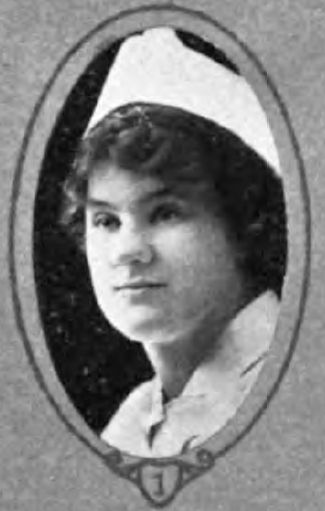
Dorothy Millman, died of a gall bladder infection after serving several months in Contrexeville. She was initially buried in the American sector of the Contrexeville cemetery - the only nurse buried there - and later reinterred for burial at the Meuse-Argonne American Cemetery, where she rests today.
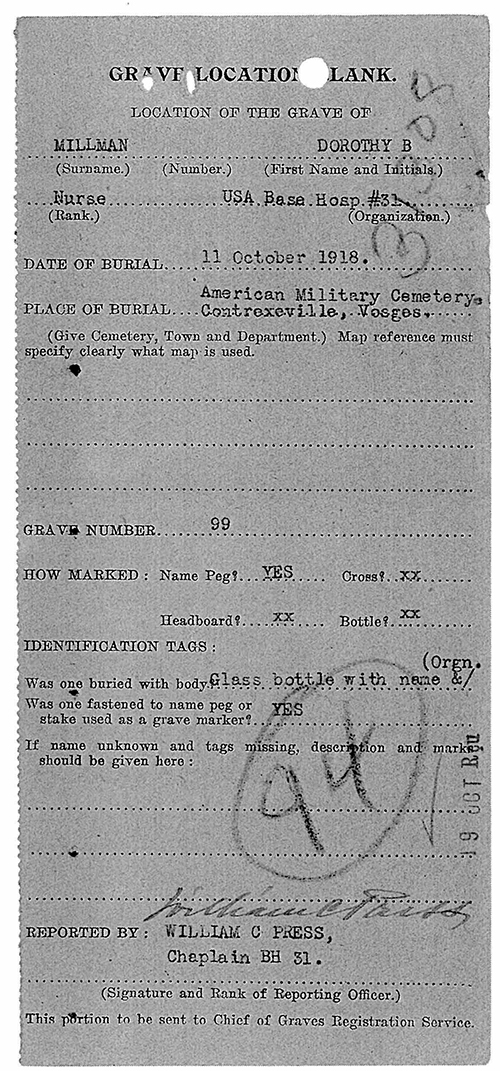
Records in Dorothy's Burial Case File confirm that her remains were first laid to rest in the American sector of the Contrexeville village cemetery. She was the only AEF nurse buried there (later reinterred at the Meuse-Argonne American Cemetery).
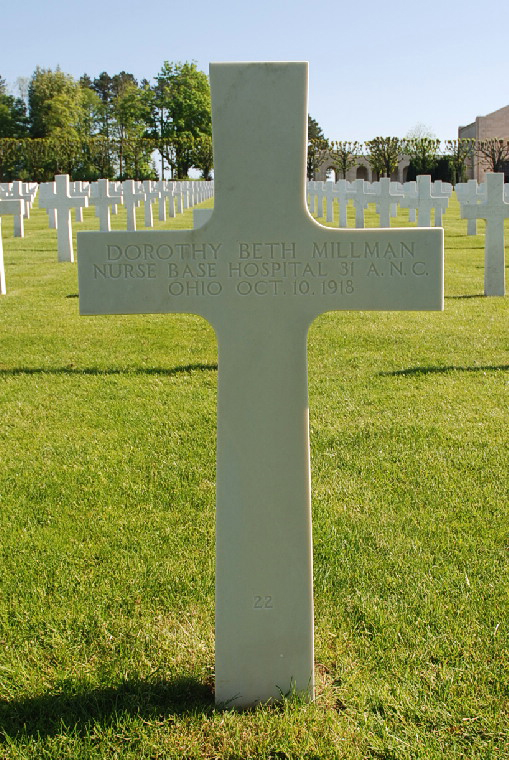
Dorothy's resting place in the Meuse-Argonne American Cemetery
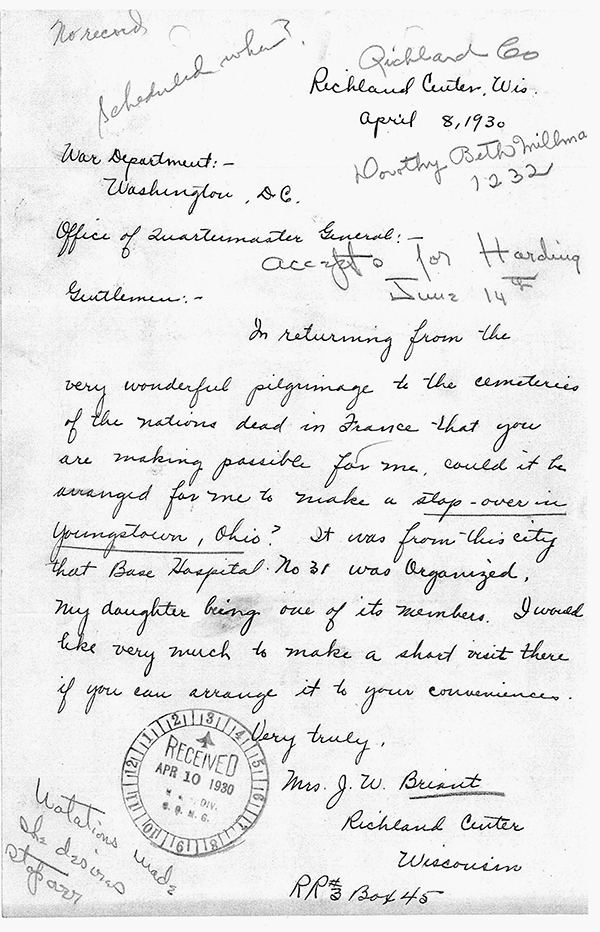
Dorothy's mother, Clara Briant, accepted the offer to visit her daughter's gravesite as part of the Gold Star Mother's Pilgrimage. She requested that she be allowed to also stop at Youngstown, OH, which was arranaged.
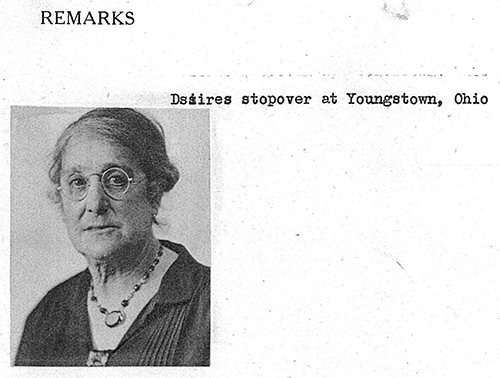
Mrs. Clara Briant, Dorothy's mother, took part in the Gold Star Mother's Pilgrimage
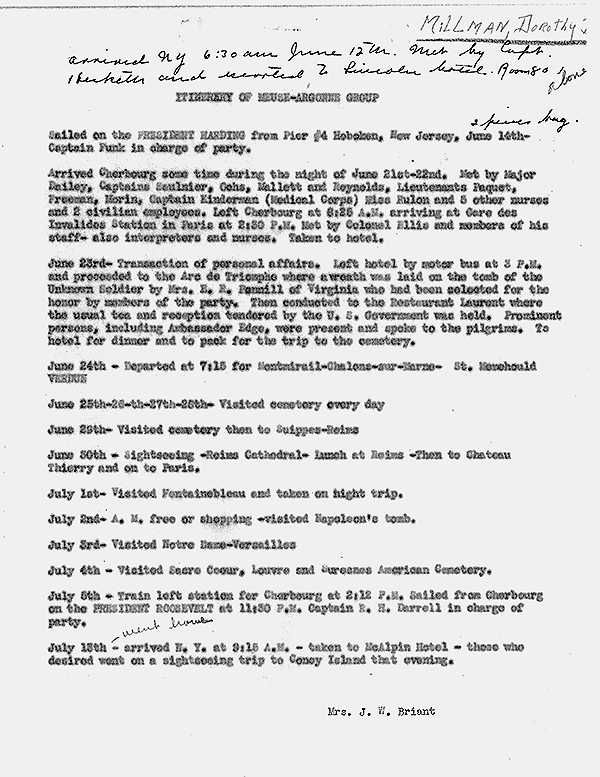
The itinerary arranged for Clara Briant's group.
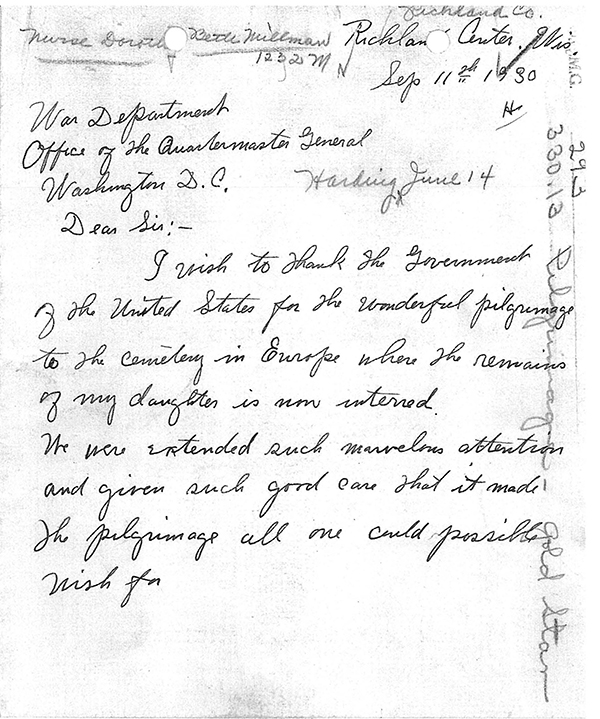
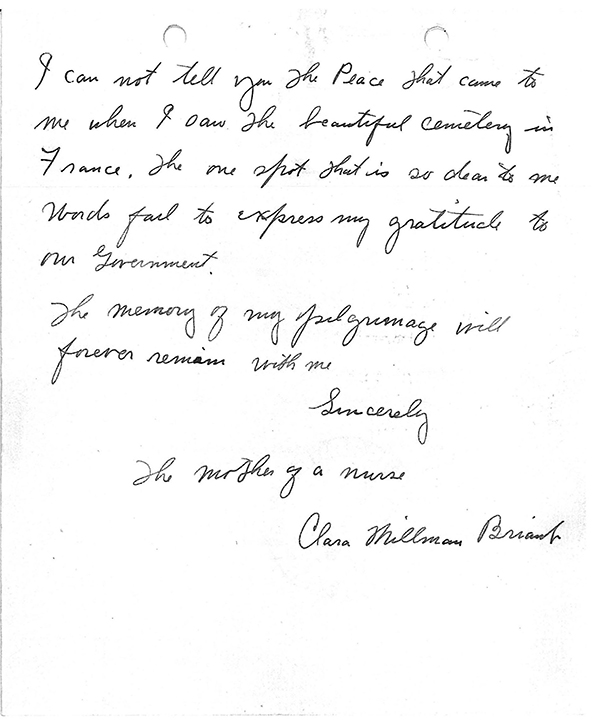
Letter from a grateful mother.

The Legion Auxiliary of the American Legion post in Youngstown honored Dorothy.